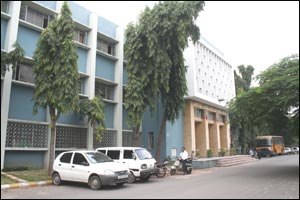Jawaharlal Nehru College Of Architecture & Fine Arts University (JNAFAU) - JNTU

Priyanka Pulla / fullhyd.com
You know the students who come here are clearly gifted when you see the various paintings, sketches, lithographs and collages on the walls of the JNTU Fine Arts building. Atleast as far as technical detail goes, these artworks are quite remarkable. Nowhere else will you see such a profusion of pieces displayed so casually. And every day, every class and every exam adds to the collection. Which is why this college is also a destination for art connoisseurs, whether visitors or local Hyderabadis, looking for the serendipitious gem in the minecave.
So what does JNTU College Of Fine Arts offer these art whizzes in addition to the inborn talent they seem to possess? The Bachelor of Fine Arts (BFA) is a 4-year course that finishes with specialisations in applied arts, paintings, sculpture and photography. Applied arts, the course with the largest takers (more than 50% of a batch) is the artistic component of advertising. This means designing print ads, hoardings, websites and even inflatables and blimps (those large advertising balloons you see dotting the sky above the Exhibition Grounds in January, and elsewhere throughout the year).
Students often work part-time after college hours since the day's happenings end conveniently as 2:30pm. By the end of 4 years, a large number are absorbed into the companies they have done projects for.
Advertising, web-design, textile design, multimedia, pharma, animation and many other industries find use for these graduates, although the pay scales are understandably highly variable. While modal salaries are around Rs. 8,000 to Rs. 10,000 for freshers, the individual talent is the point of leverage. A large number go onto study further at institutes like the NID.
While this college has famous alumni in the field of advertising, the current students still have their fair share of complaints. From a lack of updated syllabus to a lack of systems and infrastructure, there are a lot of deficiencies that catch their eye. For all the complaining, though, the output, whether the decorations on the walls or the regular art shows held in city's galleries by the students, does not seem to be affected in the least.
So what does JNTU College Of Fine Arts offer these art whizzes in addition to the inborn talent they seem to possess? The Bachelor of Fine Arts (BFA) is a 4-year course that finishes with specialisations in applied arts, paintings, sculpture and photography. Applied arts, the course with the largest takers (more than 50% of a batch) is the artistic component of advertising. This means designing print ads, hoardings, websites and even inflatables and blimps (those large advertising balloons you see dotting the sky above the Exhibition Grounds in January, and elsewhere throughout the year).
Students often work part-time after college hours since the day's happenings end conveniently as 2:30pm. By the end of 4 years, a large number are absorbed into the companies they have done projects for.
Advertising, web-design, textile design, multimedia, pharma, animation and many other industries find use for these graduates, although the pay scales are understandably highly variable. While modal salaries are around Rs. 8,000 to Rs. 10,000 for freshers, the individual talent is the point of leverage. A large number go onto study further at institutes like the NID.
While this college has famous alumni in the field of advertising, the current students still have their fair share of complaints. From a lack of updated syllabus to a lack of systems and infrastructure, there are a lot of deficiencies that catch their eye. For all the complaining, though, the output, whether the decorations on the walls or the regular art shows held in city's galleries by the students, does not seem to be affected in the least.
-
Listed In
-
Address
-
Telephone
-
Email
-
Distance1.6 km (Maps & Directions)
-
Website
-
Sub-Categories
-
Courses
-
Medium
-
Boys/Girls
-
Residential
-
Admission Criteria
-
Year Started
-
Timings
-
Closed On
-
Prices
-
Payment Option(s)
-
Closest Bus Stop
-
Closest MMTS Station
-
Add New Field:
There are no events at Jawaharlal Nehru College Of Architecture & Fine Arts University (JNAFAU) - JNTU scheduled currently.
1 - 2 OF 2 COMMENTS
1 USER
Quality
Ambience
Service/Courteousness
Value For Money
10.0
10.0
9.0
10.0
LEAVE A COMMENT
fullhyd.com has 700,000+ monthly visits. Tell Hyderabad what you feel about Jawaharlal Nehru College Of Architecture & Fine Arts University (JNAFAU) - JNTU!
RELATED LISTINGS
Door Number 2-54/4, NU Enclave, Kompally, Medchal (5.1km)
House Number 107, LIC Colony, Ambedkarnagar, Ashok Nagar (3.4km)
6-1-287, Padmarao Nagar (5.9km)
Sai Sadhan Complex, 1st Floor, Ashok Nagar (3km)
Osmania University Road, Osmania University (5.7km)
RELATED CATEGORIES
SEARCH YELLOW PAGES
Dissatisfied with the results? Report a problem or error, or add a listing.
ADVERTISEMENT
SHOUTBOX!
{{ todo.summary }}... expand »
{{ todo.text }}
« collapse
First | Prev |
1 2 3
{{current_page-1}} {{current_page}} {{current_page+1}}
{{last_page-2}} {{last_page-1}} {{last_page}}
| Next | Last
{{todos[0].name}}
{{todos[0].text}}
ADVERTISEMENT
This page was tagged for
if additions finished and without entrance exam can we enter into jntu fine arts collage
jntu college of architecture hyderabad
jnafau reviews on photography
masab tank polytechnic college
fine arts coaching centers hyderabad